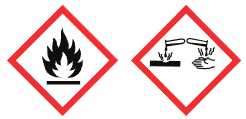Penrakis(di merhy lam i no)ranralum(V) CAS#: 19824-59-0; ChemWhat Code: 1417277
Identification
Physical Data
| Appearance | White to yellow to dark orange solid |
| Chloride ion | ≤10ppm |
| Purity | 99.9% min |
Spectra
| Description (NMR Spectroscopy) | Nucleus (NMR Spectroscopy) | Solvents (NMR Spectroscopy) | Temperature (NMR Spectroscopy), °C |
| Chemical shifts, Spectrum | 1H | ||
| Spectrum | 1H | benzene-d6 | |
| 1H | benzene-d6 | 30 |
| Description (IR Spectroscopy) |
| ATR (attenuated total reflectance), Bands |
Route of Synthesis (ROS)
| Conditions | Yield |
| Stage #1: tantalum pentachloride; dimethyl amine In n-heptane; water at -20℃; for 10h; Inert atmosphere; Stage #2: With n-butyllithium In n-heptane; water at -20℃; for 22h; Temperature; Solvent; Reflux; Experimental Procedure Under an argon atmosphere, 720 g of tantalum pentachloride and 2000 ml of water were charged into the reaction vesselN-heptane,Under stirring, 540 grams of anhydrous dimethylamine was added to the reaction kettle,The addition rate was maintained at -20 ° C,After the temperature was added to maintain the system for 10 hours,Then, n-butyllithium n-heptane (4400 ml, 2.5 mol / L)The temperature of the system was maintained at -20 ° C during the addition process, and the reaction was completed for 18 hours and then refluxed for 4 hours.Cooling first decompression to 1000Pa distilled solvent n-heptane, the temperature was 50 . After the solvent is evaporated to dryness, the solid is transferred to a sublimer,Finally, the pressure was again reduced to 50Pa sublimation products pentamethylamino) tantalum, the temperature is 50-100 , to give the productPenta (dimethylamino) tantalum698.4 g, yield 87.3%. | 87.3% |
Safety and Hazards
| Pictogram(s) |  |
| Signal | Danger |
| GHS Hazard Statements | H228 (98.39%): Flammable solid [Danger Flammable solids] H260 (98.39%): In contact with water releases flammable gases which may ignite spontaneously [Danger Substances and mixtures which in contact with water, emit flammable gases] H314 (100%): Causes severe skin burns and eye damage [Danger Skin corrosion/irritation] |
| Precautionary Statement Codes | P210, P223, P231+P232, P240, P241, P260, P264, P280, P301+P330+P331, P302+P335+P334, P302+P361+P354, P304+P340, P305+P354+P338, P316, P321, P363, P370+P378, P402+P404, P405, and P501 (The corresponding statement to each P-code can be found at the GHS Classification page.) |
Other Data
| Shelf Life | 1 year |
| Market Price |
| Druglikeness | |
| Lipinski rules component | |
| Molecular Weight | 401.33 |
| HBA | 5 |
| HBD | 0 |
| Matching Lipinski Rules | 3 |
| Veber rules component | |
| Polar Surface Area (PSA) | 16.2 |
| Rotatable Bond (RotB) | 5 |
| Matching Veber Rules | 2 |
| Use Pattern |
| Penrakis(di merhy lam i no)ranralum(V) CAS#:19824-59-0 may be used as a catalyst in certain reactions, particularly in organic synthesis. Tantalum-containing compounds can facilitate the formation of specific organic compounds. And sometimes employed as catalysts in hydrogenation reactions, especially in organic synthesis, to promote the hydrogenation of organic compounds. |
Related Chemicals
Buy Reagent | |
| No reagent supplier? | Send quick inquiry to ChemWhat |
| Want to be listed here as a reagent supplier? (Paid service) | Click here to contact ChemWhat |
Approved Manufacturers | |
| Want to be listed as an approved manufacturer (Requires approvement)? | Please download and fill out this form and send back to approved-manufacturers@chemwhat.com |
Contact Us for Other Help | |
| Contact us for other information or services | Click here to contact ChemWhat |



